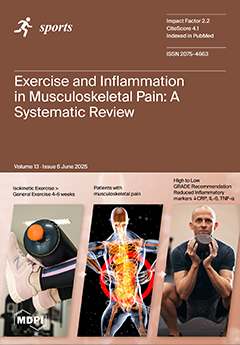Objective: Most recreational gym-goers independently consume nutritional supplements (NSs) without physician advice and a personalized diet. The present study examines the preference for nutritional supplements (NSs) based on protein and amino acids of 218 recreational gym-goers (males and females aged 18–60). It also investigates the NS’s impact on resistance training (RT) performance.
Methods: All participants (
n = 218) were regular members of two gym centers in Oradea. Baseline data and information about daily diet and supplement preferences were obtained through face-to-face interviews. At the same time, RT performance was assessed by measuring 1RM in six exercises three times (W0, W4, and W8).
Results: Our findings reveal that 24.3% of participants did not consume NSs, while the majority (75.6%,
p < 0.05) used them to improve their physical condition; men were more likely to consume NSs than women (83.3% vs. 63.9%,
p < 0.05). Gym-goers were grouped based on their NS consumption: L-carnitine, creatine, whey protein (WP), and triple combination; the non-supplemented group was the control. The combination substantially correlated with a balanced diet, 3001–3500 and >3500 calories/day; creatine was appreciably associated with 2001–2500 calories/day; L-carnitine was associated with 151–200 g protein/day, while control was considerably linked with a vegetarian diet and <1000 calorie/day (r > 0.900,
p < 0.05). The results showed that almost all participants exhibited progressive muscle strength improvements. As an overview, 1RM substantially varied with NS consumed, body weight status, and gender (
p < 0.0001), except for the pull-up count, which varied with NS and gender (
p < 0.0001). Additionally, 1RM significantly varied with age (deadlift and pull-ups), daily protein consumption (back squats, biceps, and triceps), daily calories (back squats), and diet type (biceps, triceps, and pull-up exercises),
p < 0.05. On the other hand, most NSs associated with RT exercises led to a general increase in body weight. Only L-carnitine decreased it.
Conclusions: Resistance training records of recreational athletes are significantly influenced by age, gender, body weight status, NS type, and daily diet features (
p < 0.05). Our findings highlight the essential role of professional guidance in nutritional supplementation associated with a suitable diet for optimal RT performance of recreational athletes.
Full article






